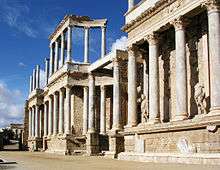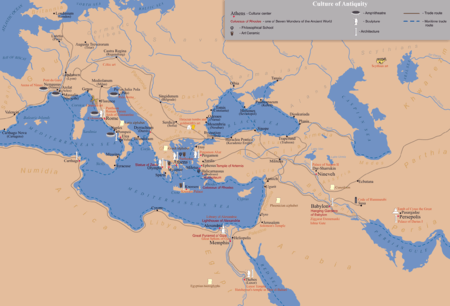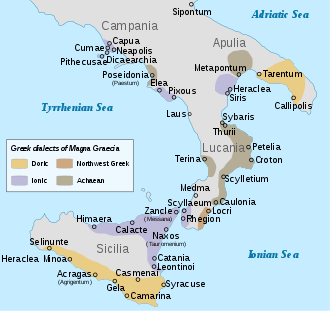Greco-Roman world
The Greco-Roman world, Greco-Roman culture or the term Greco-Roman (/ˌɡrikoʊˈroʊmən/ or /ˌɡrɛkoʊˈroʊmən/; spelled Graeco-Roman in Commonwealth), as understood by modern scholars and writers, refers to geographical regions and countries that culturally and so historically were directly and intimately influenced by the language, culture, government and religion of the ancient Greeks and Romans. A better-known term is classical civilisation. In exact terms the area refers to the "Mediterranean world", the extensive tracts of land centred on the Mediterranean and Black Sea Basins, the "swimming pool and spa" of the Greeks and the Romans in which those peoples' cultural perceptions, ideas and sensitivities were dominant.
_(30776483926).jpg)

That process was aided by the universal adoption of Greek as the language of intellectual culture and commerce in the Eastern Mediterranean Sea and of Latin as the languages of public management and forensic advocacy, especially in the Western Mediterranean.
Greek and Latin never became the native languages of the rural peasants, the great majority of the empire's population, but those were the languages of the urban and cosmopolitan elites and the empire's lingua franca, even if only as corrupt or multifarious dialects to those who lived within the large territories and populations outside the Macedonian settlements and the Roman colonies. All Roman citizens of note and accomplishment, regardless of their ethnic extractions, spoke and wrote in Greek or Latin, such as the Roman jurist and imperial chancellor Ulpian, who was of Phonecian origin; the mathematician and geographer Claudius Ptolemy, who was of Greco-Egyptian origin; and the famous post-Constantinian thinkers John Chrysostom and Augustine, who were of Syrian and Berber origins respectively. Also, the historian Josephus Flavius was of Jewish origin but spoke and wrote in Greek.
Cores

Based on the above definition, the "cores" of the Greco-Roman world can be confidently stated to have been the Italian Peninsula, Greece, Cyprus, the Iberian Peninsula, the Anatolian Peninsula (modern-day Turkey), Gaul (modern-day France), the Syrian region (modern-day Levantine countries of Israel, Central and Northern Syria, Lebanon and Palestine), Egypt and Roman Africa (corresponding to modern-day Tunisia, Eastern Algeria and Western Libya). Occupying the periphery of that world were the so-called "Roman Germany" (the modern-day Alpine countries of Austria and Switzerland and the Agri Decumates, the territory between the Main, Rhine and Danube Rivers), the Illyricum (modern-day Northern Albania, Montenegro, Bosnia and Herzegovina and the coast of Croatia), the Macedonian region, Thrace (corresponding to modern-day Southeastern Bulgaria, Northeastern Greece and the European portion of Turkey), Moesia (roughly corresponding to modern-day Central Serbia, Kosovo, Northern Macedonia, Northern Bulgaria and Romanian Dobrudja), and Pannonia (corresponding to modern-day Western Hungary, the Austrian Länder of Burgenland, Eastern Slovenia and Northern Serbia).
Also included were Dacia (roughly modern-day Romania and Moldavia), Mauretania (modern-day Morocco, Western Algeria and Northern Mauritania), Jordan, Southern Syria and Egypt's Sinai Peninsula) and the Tauric Chersonesus (modern-day Crimea and the coast of Ukraine).
The Greco-Roman world had another "world" or empire to its east, the Persians, with which there was constant interaction: Xenophon, The Anabasis, the March Up Country, the Greco-Persian wars, the famous battles of Marathon and Salamis, the Greek tragedy "The Persians" by Aeschylus, Alexander the Great's defeat of the Persian emperor Darius III and conquest of the Persian empire, or the later Roman generals' difficulties with the Persian armies, such as Pompey the Great, and of Marcus Licinius Crassus (conqueror of the slave general Spartacus), who was defeated in the field by a Persian force and was beheaded by them (Appian, The Civil Wars).
Culture
In the schools of art, philosophy and rhetoric, the foundations of education were transmitted throughout the lands of Greek and Roman rule. Within its educated class, spanning all of the "Greco-Roman" eras, the testimony of literary borrowings and influences are overwhelming proofs of a mantle of mutual knowledge. For example, several hundred papyrus volumes found in a Roman villa at Herculaneum are in Greek. The lives of Cicero and Julius Caesar are examples of Romans who frequented schools in Greece.
The installation, both in Greek and Latin, of Augustus's monumental eulogy, the Res Gestae, exemplifies the official recognition of the dual vehicles for the common culture. The familiarity of figures from Roman legend and history in the "Parallel Lives" by Plutarch is one example of the extent to which "universal history" was then synonymous with the accomplishments of famous Latins and Hellenes. Most educated Romans were likely bilingual in Greek and Latin.
Architecture
Greco-Roman architecture in the Roman world followed the principles and style that had been established by ancient Greece. That era's most representative building of was the temple. Other prominent structures that represented that style included government buildings like the Roman Senate and cultural structures like the Colosseum. The three primary styles of column design used in temples in classical Greece were Doric, Ionic and Corinthian. Some examples of Doric architecture are the Parthenon and the Temple of Hephaestus in Athens, and the Erechtheum, next to the Parthenon, is Ionic.
Politics
The Romans made it possible for individuals from subject peoples to acquire Roman citizenship and would sometimes confer citizenship on whole communities and so "Roman" became less and less an ethnic and more and more a political designation.
By AD 211, with Caracalla's edict known as the Constitutio Antoniniana, all of the empire's free inhabitants became citizens. As a result, even after the Fall of the Western Roman Empire, the people who remained within the empire continued to call themselves Romans even though Greek had become the empire's main language. They continued to call themselves Rhomaioi. (Hellenes had been referring to pagan, or non-Christian, Greeks until the Fourth Crusade.) The ensuing births of successor breakaways and the decisive and irreversible shrinking of Byzantine Greek realms finally lef to the predecesdor of Greek nationalism through the Ottoman era and even into modern times.
See also
| Wikimedia Commons has media related to Greco-Roman world. |
- Classical Antiquity
- Classical mythology
- Greco-Roman mysteries
- Greek and Roman Egypt
- Hellenistic Greece
- Legacy of the Roman Empire
- List of Greco-Roman geographers
- Magic in the Greco-Roman world
References
Sources
- Sir William Smith (ed). Dictionary of Greek and Roman Geography. London: Spottiswoode and Co, 1873.
- Simon Hornblower and Antony Spawforth (ed). Oxford Classical Dictionary. Oxford University Press, 2003.
